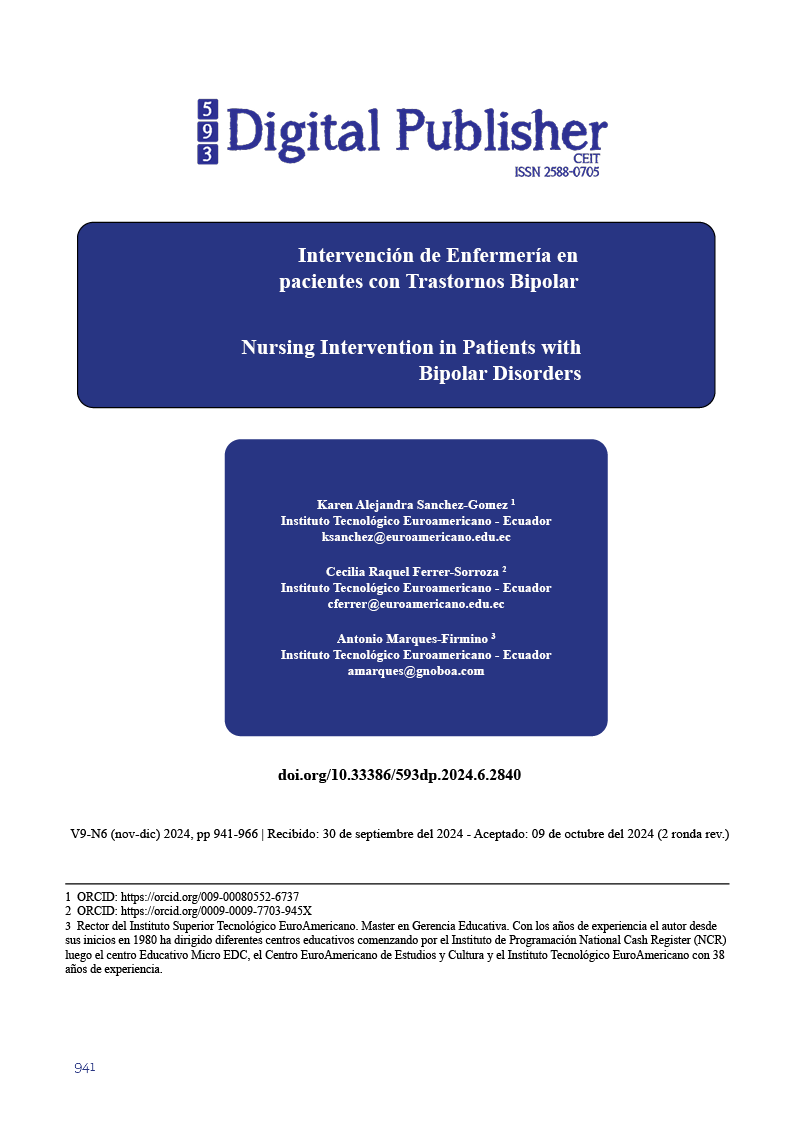Intervención de Enfermería en pacientes con Trastornos Bipolar
Contenido principal del artículo
Resumen
El establecimiento de un cuerpo de conocimientos para la enfermería sobre los pacientes con trastorno bipolar es vital para el desarrollo de un tratamiento integrado basado en la evidencia. La investigación tiene como objetivo explorar las intervenciones de enfermería en el tratamiento del trastorno bipolar I y II, abarcando todas las fases del trastorno. Se identificaron las barreras y facilitadores para el cumplimiento del tratamiento. El estudio se realizó siguiendo las directrices PRISMA para revisiones sistemáticas. Se ejecutó la búsqueda en bases de datos como Google Scholar, Scopus y PubMed, de artículos en inglés y español publicados en los últimos diez años. La extracción de datos se guió por la Plantilla Cochrane, para asegurar la confiabilidad. Se aplicó un enfoque mixto, cuantificando inicialmente las publicaciones por año, país y tipo, y posteriormente realizando una extracción cualitativa para responder preguntas específicas de investigación. Los hallazgos indican que las intervenciones de enfermería deben adaptarse a cada fase del trastorno. En la fase maníaca, la prioridad es la estabilización del estado de ánimo y la seguridad del paciente, en la fase depresiva, el objetivo se centra en mejorar el estado de ánimo y prevenir el aislamiento social. Durante la fase eutímica, se enfatiza la educación y las estrategias de estabilidad a largo plazo, fomentando la adherencia al tratamiento y la prevención de recaídas. Asimismo, se subraya la relevancia de una relación terapéutica sólida entre las enfermeras y los pacientes, que influye de manera significativa en los resultados del tratamiento y en la recuperación.
Descargas
Detalles del artículo

Esta obra está bajo una licencia internacional Creative Commons Atribución-NoComercial-CompartirIgual 4.0.
1. Derechos de autor
Las obras que se publican en 593 Digital Publisher CEIT están sujetas a los siguientes términos:
1.1. 593 Digital Publisher CEIT, conserva los derechos patrimoniales (copyright) de las obras publicadas, favorece y permite la reutilización de las mismas bajo la licencia Licencia Creative Commons 4.0 de Reconocimiento-NoComercial-CompartirIgual 4.0, por lo cual se pueden copiar, usar, difundir, transmitir y exponer públicamente, siempre que:
1.1.a. Se cite la autoría y fuente original de su publicación (revista, editorial, URL).
1.1.b. No se usen para fines comerciales u onerosos.
1.1.c. Se mencione la existencia y especificaciones de esta licencia de uso.
Citas
Akbaş, E. (2019). Nursing care for a patient with bipolar disorder (Mixed Attack) according to neuman systems model: Case report. Journal of Psychiatric Nursing. https://doi.org/10.14744/phd.2019.80774
Ameel, M., Leino, H., Kontio, R., Van Achterberg, T., & Junttila, K. (2020). Using the Nursing Interventions Classification to identify nursing interventions in free‐text nursing documentation in adult psychiatric outpatient care setting. Journal of Clinical Nursing, 29(17–18), 3435–3444. https://doi.org/10.1111/jocn.15382
American Psychiatric Association. (2013). Diagnostic and Statistical Manual of Mental Disorders (Fifth Edition). American Psychiatric Association. https://doi.org/10.1176/appi.books.9780890425596
Armijo, J. E. (2023). Bipolar spectrum disorders among American registered nurses: A narrative literature review. Discover Psychology, 3(1), 11. https://doi.org/10.1007/s44202-023-00072-8
Ata, E. E., Bahadir‐Yilmaz, E., & Bayrak, N. G. (2020). The impact of side effects on schizophrenia and bipolar disorder patients’ adherence to prescribed medical therapy. Perspectives in Psychiatric Care, ppc.12483. https://doi.org/10.1111/ppc.12483
Beaudin, J., Chouinard, M.-C., Hudon, É., & Hudon, C. (2024). Integrated self-management support provided by primary care nurses to persons with chronic diseases and common mental disorders: A qualitative study. BMC Primary Care, 25(1), 212. https://doi.org/10.1186/s12875-024-02464-8
Beentjes, T. A. A., Goossens, P. J. J., & Jongerden, I. P. (2016). Nurses’ Experience of Maintaining Their Therapeutic Relationship With Outpatients With Bipolar Disorder and Their Caregivers During Different Stages of a Manic Episode: A Qualitative Study: Nursing and Manic Stages. Perspectives in Psychiatric Care, 52(2), 131–138. https://doi.org/10.1111/ppc.12109
Bereda, G. (2022). Stage and symptoms of bipolar disorders. Insights on the Depression and Anxiety, 6(1), 007–010. https://doi.org/10.29328/journal.ida.1001030
Brickman, H. M., Young, A. S., & Fristad, M. A. (2023). Bipolar and related disorders. En Encyclopedia of Mental Health (pp. 232–239). Elsevier. https://doi.org/10.1016/B978-0-323-91497-0.00195-8
Carey-Hock, E. (2024). Experiences of self-recovery among adults with bipolar disorder: A narrative review. Mental Health Practice, 27(4), 22–27. https://doi.org/10.7748/mhp.2024.e1691
Casey, S. (2024). Preparing nursing students to communicate with mental health patients: A scoping review. Nurse Education in Practice, 80, 104099. https://doi.org/10.1016/j.nepr.2024.104099
Chen, J., & Dhillon, D. (2022). Bipolar Disorder. The Meducator, 1(42). https://doi.org/10.15173/m.v1i42.3271
Chiang, K.-J., Tsai, J.-C., Liu, D., Lin, C.-H., Chiu, H.-L., & Chou, K.-R. (2017). Efficacy of cognitive-behavioral therapy in patients with bipolar disorder: A meta-analysis of randomized controlled trials. PLOS ONE, 12(5), e0176849. https://doi.org/10.1371/journal.pone.0176849
Chou, P.-H., Liu, W.-C., Lin, W.-H., Hsu, C.-W., Wang, S.-C., & Su, K.-P. (2023). NIRS-aided differential diagnosis among patients with major depressive disorder, bipolar disorder, and schizophrenia. Journal of Affective Disorders, 341, 366–373. https://doi.org/10.1016/j.jad.2023.08.101
Coelho, J., Moreno Poyato, A., Roldán Merino, J., Sequeira, C., & Sampaio, F. (2024). Perspectives of adult patients with mental health disorders on the relationship with nurses: A focus group study. BMC Nursing, 23(1), 9. https://doi.org/10.1186/s12912-023-01663-5
Copara, O., Cumbicus, E., Morales, J., Caibe, M., & Ríos, L. (2021). Reflexiones sobre la intervención de enfermería en adultos con episodio depresivo. Revista Eugenio Espejo, 15(2), 88–97. https://doi.org/10.37135/ee.04.11.12
Crowe, M., Beaglehole, B., & Inder, M. (2016). Social rhythm interventions for bipolar disorder: A systematic review and rationale for practice. Journal of Psychiatric and Mental Health Nursing, 23(1), 3–11. https://doi.org/10.1111/jpm.12271
Darwish, D. (2024). Chatbots vs. AI Chatbots vs. Virtual Assistants. En Design and Development of Emerging Chatbot Technology (pp. 26–50). IGI Global. https://doi.org/10.4018/979-8-3693-1830-0.ch002
Durgu, N., & Dulgerler, S. (2021). The Meaning of Recovery: The Lived Experience of Patients with Bipolar Disorder in Turkey. Issues in Mental Health Nursing, 42(6), 573–580. https://doi.org/10.1080/01612840.2020.1818015
Elowe, J., Vallat, J., Castelao, E., Strippoli, M.-P. F., Gholam, M., Ranjbar, S., Glaus, J., Merikangas, K., Lavigne, B., Marquet, P., Preisig, M., & Vandeleur, C. L. (2022). Psychotic features, particularly mood incongruence, as a hallmark of severity of bipolar I disorder. International Journal of Bipolar Disorders, 10(1), 31. https://doi.org/10.1186/s40345-022-00280-6
García de la Orden, L., & García Carretero, R. (2015). Cuidados enfermeros en un paciente con trastorno bipolar y diabetes insípida nefrogénica por litio. Enfermería Clínica, 25(2), 92–97. https://doi.org/10.1016/j.enfcli.2014.12.002
Geerling, B., Lolkema, E. C., Kelders, S. M., Stevens, A. W. M. M., Kupka, R. W., & Bohlmeijer, E. T. (2023). Why patients diagnosed with bipolar disorder start, continue or discontinue health‐related apps supporting their self‐management. Journal of Psychiatric and Mental Health Nursing, 30(3), 537–546. https://doi.org/10.1111/jpm.12894
Gümüş, F., & Buzlu, S. (2018). Psychoeducation in Bipolar Disorder. Florence Nightingale Hemşirelik Dergisi, 131–139. https://doi.org/10.26650/FNJN427814
Guo, Q., Jia, J., Sun, X. L., Yang, H., & Ren, Y. (2024). Comparing the metabolic pathways of different clinical phases of bipolar disorder through metabolomics studies. Frontiers in Psychiatry, 14, 1319870. https://doi.org/10.3389/fpsyt.2023.1319870
Harmancı, P., & Yıldız, E. (2023). The effects of psychoeducation and motivational interviewing on treatment adherence and functionality in individuals with bipolar disorder. Archives of Psychiatric Nursing, 45, 89–100. https://doi.org/10.1016/j.apnu.2023.04.026
Hermans, A. P. C., Schutter, D. J. L. G., & Bethlehem, R. A. I. (2024). Functional network characteristics in anxiety- and mania-based subgroups of bipolar I disorder. Psychiatry Research: Neuroimaging, 344, 111868. https://doi.org/10.1016/j.pscychresns.2024.111868
Hormazábal‐Salgado, R., & Poblete‐Troncoso, M. (2020). Living with bipolar disorder in Chile: A qualitative study. International Journal of Mental Health Nursing, 29(3), 488–497. https://doi.org/10.1111/inm.12686
Johansen, E. R., Nielsen, H. S., & Verner, M. (2020). Long-Term Consequences of Early Parenthood. Journal of Marriage and Family, 82(4), 1286–1303. https://doi.org/10.1111/jomf.12634
Johansen, K. K., Hounsgaard, L., Frandsen, T. F., Fluttert, F. A. J., & Hansen, J. P. (2021). Relapse prevention in ambulant mental health care tailored to patients with schizophrenia or bipolar disorder. Journal of Psychiatric and Mental Health Nursing, 28(4), 549–577. https://doi.org/10.1111/jpm.12716
Johansen, K. K., Marcussen, J., Hansen, J. P., Hounsgaard, L., & Fluttert, F. (2022). Early recognition method for patients with schizophrenia or bipolar disorder in community mental health care: Illness insight, self‐management and control. Journal of Clinical Nursing, 31(23–24), 3535–3549. https://doi.org/10.1111/jocn.16181
Kadar, K. S., Andriani, A., & Tandi, D. N. (2019). Exploring mental health nursing practice in Indonesian rural area. Journal of Public Mental Health, 19(2), 119–126. https://doi.org/10.1108/JPMH-11-2018-0078
Kaplan, S. N., & Gençarslan, D. Ö. (2024). The effects of mindfulness-based psycoeducation program on the perceived stress levels and emotion regulation strategies of patients diagnosed with bipolar disorder1. Archives of Psychiatric Nursing, 52, 167–174. https://doi.org/10.1016/j.apnu.2024.07.020
Kavitha, R. R., Kamalam, S., & Rajkumar, R. P. (2022). Effectiveness of Family-Focused Nurse-led Intervention on Functional Improvement of Patients with Bipolar Disorder at a Tertiary Hospital in South India: A Randomized Controlled Trial. Indian Journal of Psychological Medicine, 44(2), 152–159. https://doi.org/10.1177/02537176211060557
Keshavarzpir, Z., Seyedfatemi, N., Mardani-Hamooleh, M., Esmaeeli, N., & Boyd, J. E. (2021). The Effect of Psychoeducation on Internalized Stigma of the Hospitalized Patients with Bipolar Disorder: A Quasi-Experimental Study. Issues in Mental Health Nursing, 42(1), 79–86. https://doi.org/10.1080/01612840.2020.1779881
Khedr, M. A., El-Ashry, A. M., El-Sayed, M. M., Elkot, M. A., & Hussein, R. M. (2024). The effect of physical exercises program on social functioning, alexithymia, and sense of coherence among patients with bipolar disorders: A randomized control trial. Archives of Psychiatric Nursing, 49, 83–92. https://doi.org/10.1016/j.apnu.2024.02.002
Kragh, M., Dyrberg, H., Speed, M., Pedersen, P., Kristiansen, S. T., & Martiny, K. (2024). The efficacy of a transdiagnostic sleep intervention for outpatients with sleep problems and depression, bipolar disorder, or attention deficit disorder: Study protocol for a randomized controlled trial. Trials, 25(1), 57. https://doi.org/10.1186/s13063-024-07903-6
Lázaro, P. G., Torres López, J., Jimenez Zamudio, M. J., & Hernández Martínez, A. (2024). Atención de Enfermería a una Persona con trastorno Afectivo Bipolar, Episodio Maniaco con Síntomas Psicóticos Basada en el Modelo de Adaptación de Callista Roy. Ciencia Latina Revista Científica Multidisciplinar, 8(3), 11042–11058. https://doi.org/10.37811/cl_rcm.v8i3.12264
Liu, J. (2024). The Transition Between Depressive Episode and Manic Episode During the Treatment of Bipolar Disorder. Lecture Notes in Education Psychology and Public Media, 59(1), None-None. https://doi.org/10.54254/2753-7048/59/20241702
Ljubic, N., Ueberberg, B., Grunze, H., & Assion, H.-J. (2023). Treatment of Bipolar Disorders in Older Adults: A Review. Focus, 21(4), 434–443. https://doi.org/10.1176/appi.focus.23021024
Loots, E., Dilles, T., Hadouchi, S., Van Rompaey, B., & Morrens, M. (2023). The attitude of healthcare providers towards medication self‐management in hospitalized patients diagnosed with schizophrenia or bipolar disorders. Journal of Psychiatric and Mental Health Nursing, 30(4), 761–772. https://doi.org/10.1111/jpm.12903
Loots, E., Goossens, E., Vanwesemael, T., Morrens, M., Van Rompaey, B., & Dilles, T. (2021). Interventions to Improve Medication Adherence in Patients with Schizophrenia or Bipolar Disorders: A Systematic Review and Meta-Analysis. International Journal of Environmental Research and Public Health, 18(19), 10213. https://doi.org/10.3390/ijerph181910213
Maget, A., Platzer, M., Bengesser, S. A., Fellendorf, F. T., Birner, A., Queissner, R., Hamm, C., Reininghaus, B., Hecker, A., Tomberger, L., Pilz, R., Dalkner, N., Moll, N., Schütze, G., Schwarz, M., Kapfhammer, H. P., & Reininghaus, E. Z. (2020). Differences in Kynurenine Metabolism During Depressive, Manic, and Euthymic Phases of Bipolar Affective Disorder. Current Topics in Medicinal Chemistry, 20(15), 1344–1352. https://doi.org/10.2174/1568026619666190802145128
Massa, L., Abelli, M., Forfori, F., Di Luca, P., Benvenuti, A., Palagini, L., Pacciardi, B., Raia, A., Caruso, V., & Pini, S. (2023). Binge eating disorder, impulsivity and bipolar spectrum features in a sample of obese candidates for bariatric surgery. Rivista di Psichiatria, 58(2), 76–83.
McCombe, G., Fogarty, F., Swan, D., Hannigan, A., Fealy, G. M., Kyne, L., Meagher, D., & Cullen, W. (2018). Identified mental disorders in older adults in primary care: A cross-sectional database study. European Journal of General Practice, 24(1), 84–91. https://doi.org/10.1080/13814788.2017.1402884
McCormick, U., Murray, B., & McNew, B. (2015). Diagnosis and treatment of patients with bipolar disorder: A review for advanced practice nurses. Journal of the American Association of Nurse Practitioners, 27(9), 530–542. https://doi.org/10.1002/2327-6924.12275
Miola, A., Tondo, L., Pinna, M., Contu, M., & Baldessarini, R. J. (2023). Comparison of bipolar disorder type II and major depressive disorder. Journal of Affective Disorders, 323, 204–212. https://doi.org/10.1016/j.jad.2022.11.039
Moher, D., Shamseer, L., Clarke, M., Ghersi, D., Liberati, A., Petticrew, M., Shekelle, P., & Stewart, L. A. (2015). Preferred reporting items for systematic review and meta-analysis protocols (PRISMA-P) 2015 statement. Systematic Reviews, 4(1), 1. https://doi.org/10.1186/2046-4053-4-1
Öksüz, E., Mersin, S., Uçgun, T., & Sarikoc, G. (2024). Experiences of nurses providing care to hospitalized patients with acute mania in Türkiye: A phenomenological study. Archives of Psychiatric Nursing, 50, 33–39. https://doi.org/10.1016/j.apnu.2024.03.005
Ortega, T. I. (2016). Trastorno bipolar: Garantías explícitas de salud e implicancias para enfermería. Horizonte de Enfermería, 27(1), Article 1.
Page, M. J., McKenzie, J. E., Bossuyt, P. M., Boutron, I., Hoffmann, T. C., Mulrow, C. D., Shamseer, L., Tetzlaff, J. M., Akl, E. A., Brennan, S. E., Chou, R., Glanville, J., Grimshaw, J. M., Hróbjartsson, A., Lalu, M. M., Li, T., Loder, E. W., Mayo-Wilson, E., McDonald, S., … Moher, D. (2021). The PRISMA 2020 statement: An updated guideline for reporting systematic reviews. BMJ, n71. https://doi.org/10.1136/bmj.n71
Palagini, L., Miniati, M., Marazziti, D., Franceschini, C., Zerbinati, L., Grassi, L., Sharma, V., & Riemann, D. (2022). Insomnia symptoms are associated with impaired resilience in bipolar disorder: Potential links with early life stressors may affect mood features and suicidal risk. Journal of Affective Disorders, 299, 596–603. https://doi.org/10.1016/j.jad.2021.12.042
Permana, G. G. S. (2024). Providing Psychological Nursing Care at Mental Rehabilitation Clinic, Addressing Self-Concept Challenges: Low Self-Worth Alongside a Bipolar Diagnosis. Nursing Case Insight Journal, 2(1), Article 1.
Simjanoski, M., Patel, S., Boni, R. D., Balanzá-Martínez, V., Frey, B. N., Minuzzi, L., Kapczinski, F., & Cardoso, T. D. A. (2023). Lifestyle interventions for bipolar disorders: A systematic review and meta-analysis. Neuroscience & Biobehavioral Reviews, 152, 105257. https://doi.org/10.1016/j.neubiorev.2023.105257
Tahghighi, H., Mortazavi, H., Manteghi, A. A., & Armat, M. R. (2023). The effect of comprehensive individual motivational-educational program on medication adherence in elderly patients with bipolar disorders: An experimental study. Journal of Education and Health Promotion, 12(1). https://doi.org/10.4103/jehp.jehp_1109_22
Tondo, L., Miola, A., Pinna, M., Contu, M., & Baldessarini, R. J. (2022). Differences between bipolar disorder types 1 and 2 support the DSM two-syndrome concept. International Journal of Bipolar Disorders, 10(1), 21. https://doi.org/10.1186/s40345-022-00268-2
Uçgun, T., & Öksüz, E. (2024). The relationship between biological rhythm and perceived social support, coping styles and medication adherence in patients with bipolar disorder in Türkiye. Archives of Psychiatric Nursing, 48, 68–73. https://doi.org/10.1016/j.apnu.2024.01.013
Van Den Heuvel, S. C. G. H., Goossens, P. J. J., Terlouw, C., Schoonhoven, L., & Van Achterberg, T. (2019). Self-Management Education for Bipolar Disorders: A Hermeneutic-Phenomenological Study on the Tacit Knowledge of Mental Health Nurses. Issues in Mental Health Nursing, 40(11), 942–950. https://doi.org/10.1080/01612840.2019.1636166
Van Der Voort, T. Y. G., Van Meijel, B., Hoogendoorn, A. W., Goossens, P. J. J., Beekman, A. T. F., & Kupka, R. W. (2015). Collaborative care for patients with bipolar disorder: Effects on functioning and quality of life. Journal of Affective Disorders, 179, 14–22. https://doi.org/10.1016/j.jad.2015.03.005
vanLankeren, J. E., Testerink, A. E., Daggenvoorde, T. H., Poslawsky, I. E., & Goossens, P. J. J. (2020). Patient experiences with nursing care during hospitalization on a closed ward due to a manic episode: A qualitative study. Perspectives in Psychiatric Care, 56(1), 37–45. https://doi.org/10.1111/ppc.12370
Wakelin, R., & Oakes, P. (2019). Clinicians’ perceptions of the Bipolar Disorder diagnosis: A Q-study. The Journal of Mental Health Training, Education and Practice, 15(1), 1–12. https://doi.org/10.1108/JMHTEP-08-2018-0045
Wang, X., & Yu, Y. (2021). Application of systematic nursing in patients with maniac access of bipolar disorder and its impact on treatment compliance and quality of life. American Journal of Translational Research, 13(6), 6929–6936.
Yu, H., Li, M.-L., Meng, Y., Li, X.-J., Wei, W., Li, Y.-F., Li, L., Guo, W., Wang, Q., Deng, W., Ma, X., Coid, J., & Li, T. (2021). Inferior frontal gyrus seed-based resting-state functional connectivity and sustained attention across manic/hypomanic, euthymic and depressive phases of bipolar disorder. Journal of Affective Disorders, 282, 930–938. https://doi.org/10.1016/j.jad.2020.12.199
Zeighami, R., Raeisolhagh, A., & Ranjbaran, M. (2021). Effect of Home Nursing Care on the Severity of Symptoms in Patients With Bipolar I Disorder: A Randomized Clinical Trial. Home Health Care Management & Practice, 33(2), 81–87. https://doi.org/10.1177/1084822320969122
Zeighami, R., Raeisolhagh, A., & Ranjbaran, M. (2023). Follow-up of Symptoms of Patients with Type 1 Bipolar Disorder After Home Nursing Care: A Randomized Controlled Trial. Jundishapur Journal of Chronic Disease Care, 13(1). https://doi.org/10.5812/jjcdc-138664




